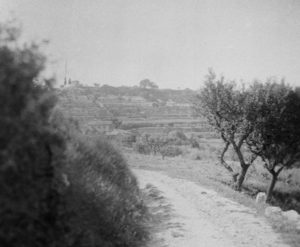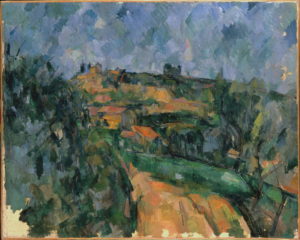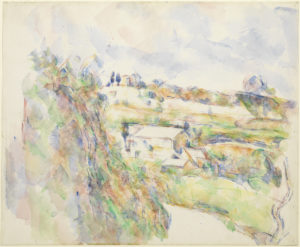R946 – La Route tournante en haut du chemin des Lauves, vers 1904 (FNW378)
RW629 – Maison près d’un tournant en haut du chemin des Lauves, 1904-1906
Pavel Machotka
(Cliquer sur les images pour les agrandir)
With the discovery of a photograph of one of Cézanne’s motifs that must have been taken by someone who had been on the site (probably Emile Bernard in 1904), any doubts about the value of knowing what it was that Cézanne transformed into art should be put to rest. The view is contemporary; the depth of Cézanne’s attachment to the motif can be seen as clearly as his construction of a parallel version of it. We have in fact two constructions, each faithful to the site and each forming a parallel system appropriate to its medium.

Photographie trouvée dans l’atelier des Lauves, vraisemblablement prise par Emile Bernard en 1904 (détail)
The painting appears to be closer to the photograph, but that is only because both take in a wider view than the watercolor. Cézanne looks further down and to the right, so that the wider angle makes the house with the red roof seem further away and smaller. The coral-red color dominates our attention (all the more so as it is nestled in greens), coming toward us just as the building half-disappears behind the hill and completes the turn in the road. Following the road back down, we encounter the two small trees in the place where Cézanne had found them, in the very place where they are needed to contain the precipitous descent of the road and the fields. The space of the painting may be seen either as expanding or contracting; when it contracts, we reach the dense farmhouse and our gaze stops, having gone as far into the composition’s core as the painter allows.
The watercolor shimmers with another kind of intensity. The hillside that frames the view on the left cannot quite bear the weight it has in the oil; dark and massive in reality, it could easily become muddy and opaque in the watercolor, and much too heavy for the rest of the picture. Cézanne’s touches, separate and fully dry before the next one is superimposed, skirt both dangers: the hillside remains light in weight (and becomes more so as it moves toward the corner). As in his other late landscapes in watercolor, it is composed of the same hues as the rest of the sheet (although in different proportions) and remains intimately integrated with it. The painting as a result takes shape from its colored segments and from the edges of its components; our attention is evenly directed over the entire surface, never focused on a flat expanse of a local hue. The result is clear, suggestive and yet fully comprehensible, deeply unified in color and touch.
La route tournante was painted in about the same year as three riverside landscapes in the north: Bords d’une rivière, Paysage au bord d’une rivière, and Bords d’une rivière (R925-FWN370). All four are painted in the late style, with broad patches assembled into an animated, vibrant whole, and may be viewed with equal admiration. Because the three riverside scenes represent a horizontal landscape, of course, their compositions are naturally calmer. But it is the difference in the painter’s touch that is most significant: emotionally closer to his native soil, in La route tournante Cézanne is attentive to many more relationships of forms and colors, and paints the equivalent of a rich mosaic. All four are masterly representations; La route tournante is also an intimate experience of space, movement, and habitation.
Source: Machotka, Cézanne: Landscape into Art.



